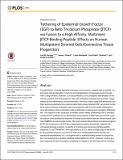Tethering of Epidermal Growth Factor (EGF) to Beta Tricalcium Phosphate (βTCP) via Fusion to a High Affinity, Multimeric βTCP-Binding Peptide: Effects on Human Multipotent Stromal Cells/Connective Tissue Progenitors
Author(s)
Alvarez, Luis M.; Rivera, Jaime J.; Stockdale, Linda; Saini, Sunil; Lee, Richard T.; Griffith, Linda G.; ... Show more Show less
DownloadAlvarez-2015-Tethering of Epiderm.pdf (1.993Mb)
PUBLISHER_CC
Publisher with Creative Commons License
Creative Commons Attribution
Terms of use
Metadata
Show full item recordAbstract
Transplantation of freshly-aspirated autologous bone marrow, together with a scaffold, is a promising clinical alternative to harvest and transplantation of autologous bone for treatment of large defects. However, survival proliferation, and osteogenic differentiation of the marrow-resident stem and progenitor cells with osteogenic potential can be limited in large defects by the inflammatory microenvironment. Previous studies using EGF tethered to synthetic polymer substrates have demonstrated that surface-tethered EGF can protect human bone marrow-derived osteogenic stem and progenitor cells from pro-death inflammatory cues and enhance their proliferation without detriment to subsequent osteogenic differentiation. The objective of this study was to identify a facile means of tethering EGF to clinically-relevant βTCP scaffolds and to demonstrate the bioactivity of EGF tethered to βTCP using stimulation of the proliferative response of human bone-marrow derived mesenchymal stem cells (hBMSC) as a phenotypic metric. We used a phage display library and panned against βTCP and composites of βTCP with a degradable polyester biomaterial, together with orthogonal blocking schemes, to identify a 12-amino acid consensus binding peptide sequence, LLADTTHHRPWT, with high affinity for βTCP. When a single copy of this βTCP-binding peptide sequence was fused to EGF via a flexible peptide tether domain and expressed recombinantly in E. coli together with a maltose-binding domain to aid purification, the resulting fusion protein exhibited modest affinity for βTCP. However, a fusion protein containing a linear concatamer containing 10 repeats of the binding motif the resulting fusion protein showed high affinity stable binding to βTCP, with only 25% of the protein released after 7 days at 37[superscript o]C. The fusion protein was bioactive, as assessed by its abilities to activate kinase signaling pathways downstream of the EGF receptor when presented in soluble form, and to enhance the proliferation of hBMSC when presented in tethered form on commercial βTCP bone regeneration scaffolds.
Date issued
2015-06Department
Massachusetts Institute of Technology. Department of Biological EngineeringJournal
PLOS ONE
Publisher
Public Library of Science
Citation
Alvarez, Luis M., Jaime J. Rivera, Linda Stockdale, Sunil Saini, Richard T. Lee, and Linda G. Griffith. “Tethering of Epidermal Growth Factor (EGF) to Beta Tricalcium Phosphate (βTCP) via Fusion to a High Affinity, Multimeric βTCP-Binding Peptide: Effects on Human Multipotent Stromal Cells/Connective Tissue Progenitors.” Edited by Masaya Yamamoto. PLoS ONE 10, no. 6 (June 29, 2015): e0129600.
Version: Final published version
ISSN
1932-6203